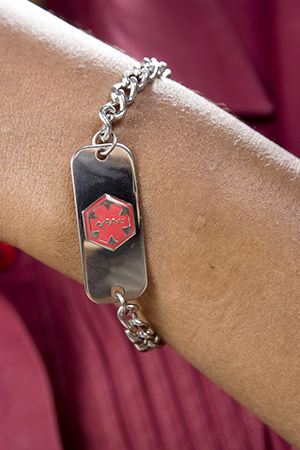Latex Allergy
What is a latex allergy?
Natural rubber latex is a milky fluid found in rubber trees. There is a protein in the fluid that can cause allergic reactions in some people. Common products made using this natural rubber latex include gloves, condoms, rubber bands, and balloons.
There are 2 types of latex allergy. One type can cause a reaction right away. For example, it's like what someone with a peanut allergy may have after eating a peanut. The other type is much more common. It causes a delayed skin rash 1 to 3 days after exposure. This is similar to a reaction that often occurs after you have been exposed to poison ivy.
What causes a latex allergy?
An allergy is an extreme sensitivity to a certain substance (allergen). Latex protein is the allergen that causes a latex allergy. People with a latex allergy have a reaction when latex comes in contact with their skin, or with mucous membranes (such as the nostrils, mouth, or rectum), or the bloodstream (during surgery). For example, some people may react when blowing up a rubber balloon or breathing in powder from the inside of latex gloves.
Who is at risk for a latex allergy?
People who have frequent exposure to latex have a higher risk of developing a latex allergy. They include:
People who have allergies to certain foods may also have a latex allergy. These foods include:
-
Bananas
-
Avocados
-
Chestnuts
-
Kiwi
-
Passion fruit
-
Papaya
-
Figs
-
Peaches
-
Tomatoes
-
White potato
-
Bell pepper
-
Celery
What are the symptoms of a latex allergy?
The symptoms of a latex allergy are:
-
Itchy or watery eyes
-
Runny nose or sneezing
-
Wheezing or whistling sound while breathing
-
Raised, red, itchy bumps on the skin (hives)
-
A skin rash that occurs after the skin comes in contact with latex
-
Pain or itching during sex when using latex condoms or a diaphragm
In some cases, a severe or life-threatening reaction can happen. This is called anaphylaxis or anaphylatic reaction. Symptoms may include:
Call 911 immediately for symptoms of anaphylaxis. An anaphylactic reaction needs emergency treatment right away.
How is a latex allergy diagnosed?
Your healthcare provider will ask about your health history and do a physical exam. You may also have blood tests.
How is a latex allergy treated?
Your healthcare provider may give you certain medicines to ease your symptoms. They may prescribe epinephrine, such as an epinephrine autoinjector or nasal spray, to treat anaphylaxis. The only way to treat or prevent this type of allergy is to stay away from items with latex. Products that may have latex are:
These medical supplies can also have latex in them:
There are items that can be used in place of these items. They are made from vinyl, plastic, or silicone.
What are possible complications of a latex allergy?
The main complication of a latex allergy is anaphylaxis. It’s a severe reaction that can be life-threatening. It needs emergency treatment right away.
How do I manage a latex allergy?
Here are some tips for coping with your latex allergy:
-
Try to stay away from all latex products. Read labels and use items that don’t have latex in them. Don't assume that "hypoallergenic" products don't have latex in them
-
If you need surgery or a procedure, talk with your healthcare provider about what you can do to prevent exposure and reactions to latex.
-
Wear a medical alert bracelet or necklace with information about your allergy.
-
Carry a pair of nonlatex gloves with you, such as nitrile gloves, information about latex allergies, or a note from your healthcare provider.
-
Check that health and school records have a latex allergy alert.
-
Tell restaurants about your latex allergy. Some food handlers will use latex gloves to prepare foods. This can be a hidden cause of latex allergy exposures and reactions.
-
Ask your healthcare provider about how to use epinephrine. Carry 2 epinephrine doses with you at all times.
-
Know what to do if an emergency occurs.

Key points about a latex allergy
-
Natural rubber latex is a milky fluid found in rubber trees. Some people are allergic to a protein in this fluid.
-
People with a latex allergy have a reaction when latex comes in contact with their skin, mucous membranes, or the bloodstream.
-
The symptoms of a latex allergy may include itchy or watery eyes, wheezing, or hives.
-
Another type of latex allergy is a rash that can appear after several days.
-
A severe reaction may cause anaphylaxis, which is a life-threatening emergency.
-
Staying away from products that have latex in them is the only way to treat or prevent this allergy.
Next steps
Tips to help you get the most from a visit to your healthcare provider:
-
Know the reason for your visit and what you want to happen.
-
Before your visit, write down questions you want answered.
-
Bring someone with you to help you ask questions and remember what your provider tells you.
-
At the visit, write down the name of a new diagnosis and any new medicines, treatments, or tests. Also write down any new directions your provider gives you.
-
Know why a new medicine or treatment is prescribed and how it will help you. Also know what the side effects are.
-
Ask if your condition can be treated in other ways.
-
Know why a test or procedure is recommended and what the results could mean.
-
Know what to expect if you do not take the medicine or have the test or procedure.
-
If you have a follow-up appointment, write down the date, time, and purpose for that visit.
-
Know how you can contact your healthcare provider if you have questions.